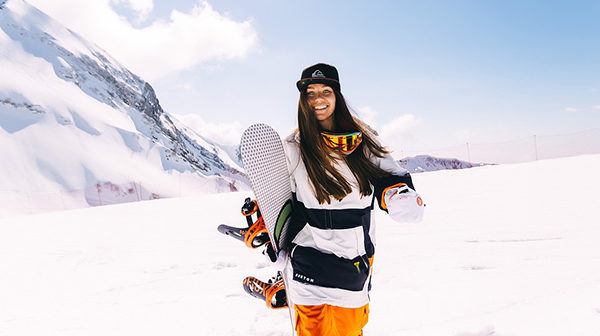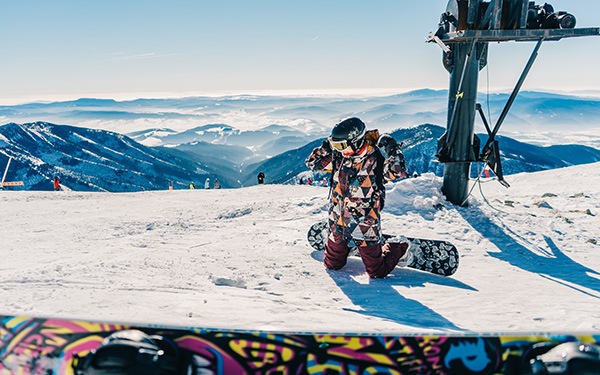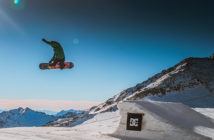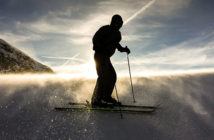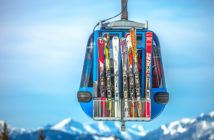If you’re looking for the best all mountain snowboard, we’ve got you covered.
These rides will guarantee you performance and fun in every type of terrain — whether you’re jibbing in the park or taking on some fresh powder off piste.
All mountain snowboards are definitely the model to look at if you’re after flexibility and versatility. They’re not specialists, but they’re damn good generalists — and they’ll serve most passionate boarders well in the snow.
We’ve compiled this complete buying guide, as well as a list of the best all mountain snowboards of 2020.
Here’s a sneak peek at our top 3 if you’re curious:
| Best For... | Versatility in all Terrains | Advanced Playfulness | Value |
| Profile | Hybrid Rocker-Camber | Hybrid Flat with Rocker | Hybrid Rocker-Camber |
| Shape | Directional Twin | Directional Twin | Directional Twin |
| Flex | Medium | Medium | Medium-Stiff |
Choose one of these bad boys and you can’t go wrong.
Let’s get straight into it…
Contents
What is an All Mountain Snowboard?
An all mountain snowboard is exactly what it sounds like — a board you can use anywhere on the mountain.
That’s right — in the park, down the groomers and even off piste.
These babies are masters of versatility and are the hallmark of any snowboarder’s kit.
It’s always tempting to splurge on a specialist board — especially if your budget is tight — but the truth is that no other board, whether it be park, freeride, freestyle or alpine, is going to give you the same opportunities as an all mountain.
And if you invest wisely in the best all mountain snowboard for your circumstances, you’ll be blessed with a board that can perform just as well as something more specialist but that allows you so much more freedom.
It almost goes without saying that all mountain snowboards are particularly well suited to beginners and intermediates — but truly they’re a gift on the slopes whatever your experience and ability level is.
What Makes the Best All Mountain Snowboard?
Before we reveal our favorite all mountain snowboards, it’s worth taking some time to understand more about the board itself. This way you can make the best informed decision for your own circumstances and situation.
Here are the top features and concepts you should be looking out for during your product browsing.
Versatility
As we’ve already mentioned, the number one feature of the best all mountain snowboard is the versatility it offers you.
It’s no good if you fork out for an expensive board that floats beautifully in powder but can’t handle moving at speed down the groomers. The reason you want an all mountain snowboard is for its versatility and so it should be the number one thing you look for in this category.
Of course, not all boards are created equally and, as such, some are more versatile than others.
This isn’t necessarily a bad thing: if you have any experience snowboarding at all, you probably already have a certain terrain preference. Just because you might want the opportunity to explore other conditions doesn’t mean that you shouldn’t pick a snowboard that leans more towards the type of terrain you board on the most.
Ability to Float in Powder
Another super important feature to consider in the best all mountain snowboards is how well they float in powder.
Is the board going to set you free to explore off piste and fresh snow to your heart’s desire? Or are you going to get stuck in deep pow?
Depending on how often you estimate taking your board out on the powder will depend on how important ‘floatiness’ is to you.
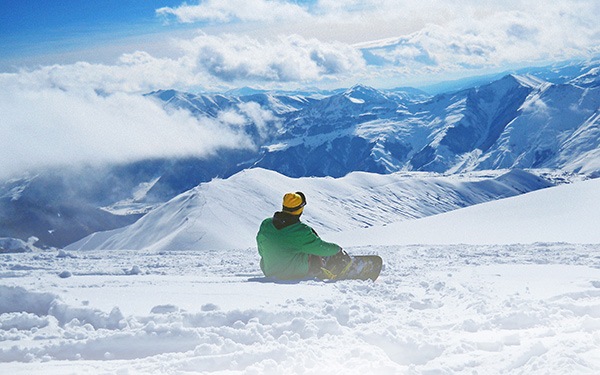
Edge Hold
If you’re planning to race down hardpack and ice, edge hold is a really important feature in your snowboard.
This will allow you plenty of safety and stability in a variety of challenging conditions — allowing you to push further and faster without washing out.
Always a good thing.
But edge hold is actually a doubled-edged (sorry) sword.
While it’s essential for performance when you’re freeriding or boarding down hardpack, it’s not quite so important if you spend most of your time in soft snow.
And if you’re freestyling in the park, too much edge hold can actually hold you back as big edges are prone to catch on obstacles.
So again, this is another feature where you have to weigh up what’s most important to you and what type of terrain you’re mostly going to be boarding in.
As all mountain snowboards are known for versatility, most will have at least some degree of edge hold to cater to the snowboarders who are using it to explore different and challenging types of terrain.
If you’re planning on spending almost all of your time in the park, it’s probably worth looking at a specialist freestyle board instead.
Stability
Another feature important to people who plan on using their boards at high speeds is how stable it remains when you’re traveling fast.
Again, you don’t want to wash out so stability is crucial — particularly if you’re not a super experienced snowboarder.
In tandem with edge hold, stability at speed will allow you to pull off high-speed carves and turns with the best of them.
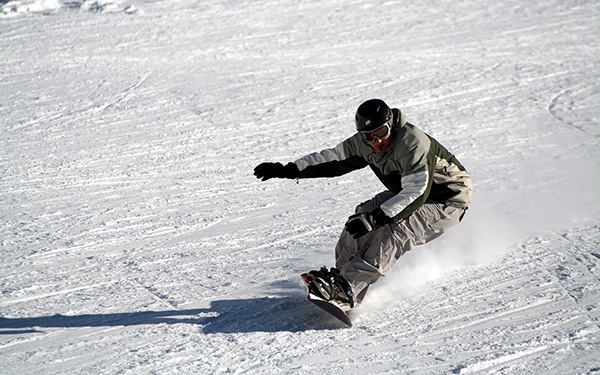
Responsive
How responsive your all mountain snowboard is will be especially important for snowboarders with less experience and confidence.
A high degree of responsiveness is great for boarders who desire control at all speeds and in all terrains.
Less responsive boards generally require more power and aggression behind them to truly make them sing, so they’re better suited to higher abilities and experience levels.
Generally, lighter snowboards make for more responsiveness.
Larger and heavier boards — those more suited to tearing down groomers and hardpack — can be lacking on the responsive side.
Pop
Another really important — if sometimes underrated — feature of all mountain snowboards is how well they pop.
Snap and crackle are another matter altogether.
If you’re new to snowboarding and wondering what on earth ‘pop’ is, it’s essentially how much spring or boost the board exhibits when you’re jumping and jibbing.
Just like edge hold, working out how much pop is best for you can be a fine line.
You want enough there to boost a really playful ride but not so much that it spooks you — inexperienced snowboarders may prefer boards with a lower level of pop.
But generally speaking and for most snowboarders, pop is a good thing — the more, the better. A high degree of pop also indicates how well your snowboard might turn.
The best all mountain snowboards will retain their pop throughout their lifetime. Lower quality models may see pop weaken with wear and tear.
How much pop a snowboard exhibits also informs how playful the snowboard is. The more rebound energy on offer for a board, the more fun you can have with it!
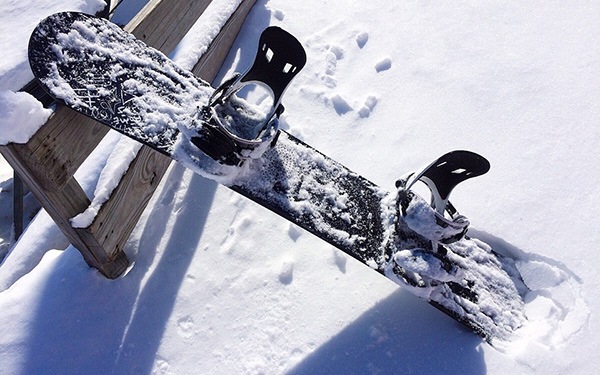
All Mountain Snowboard Specs
Before we reveal the best all mountain snowboards of 2020, it’s a good idea to quickly run through the terminology we’ll be using to define each board.
Profile
Camber, rocker and flat are the types of profile that a snowboard can have.
All mountain snowboards often have a combination of camber, rocker and flat in their profile to make them as versatile as possible — rockered tips and tails with a camber underfoot for instance. Or a flat tail and rockered tips.
We’ll go through each of these so you know what you’re looking for.
Camber
A cambered snowboard will see the ends of the board in contact with the snow and a slight upward rise in the middle.
This profile favors precision, pop and power in hard snow, and as such is best suited to those who like to race down groomers.
Rocker
Rocker, on the other hand, is the exact inverse with the middle of the board in contact with the snow and the ends tilted upwards.
Hence why it’s also known as reverse camber.
Rockered boards are great for floating in fresh powder, easy to initiate turns with and don’t have the edge hold of cambered snowboards.
As such, they’re most popular for those who spend a lot of time in fresh pow.
Their extra maneuverability also means that they’re a good choice for beginner snowboarders.
Flat
Flat snowboards are just that — flat with contact throughout the length of the ski with perhaps a tiny rocker up at the ends.
Flat boards are for people looking for something between the extremes offered by rocker and camber. More maneuverable than cambered boards but with more edge hold than rockered, for instance.
Shape
It’s not just the profile which you need to look at when buying an all mountain snowboard — it’s the entire shape of the board too.
Let’s take a look at the different type of shapes on offer…
Directional
The directional shape is pretty common in all mountain snowboards thanks to the versatility it offers — it’s well suited to both powder floating and carving down hardpack.
As the name suggests, the directional shape is best for riding forwards — this shape is no good for the park.
You can immediately tell a directional board from it’s tapered point nose. Your stance will be set quite far back towards the tail.
Twin
A twin snowboard is where the nose and tail are the same — a mirror image of each other.
As such, they’re good for riding both backwards and forwards, hence why they’re often favored by park riders.
Stance is generally center on twin boards.
Directional Twin
Probably the most common shape for all mountain snowboards is the directional twin.
This is where the nose and tail are the same shape but the stance is found slightly further back towards the tail.
As such, these snowboards are engineered to ride forwards as well as perform tricks and jibs.
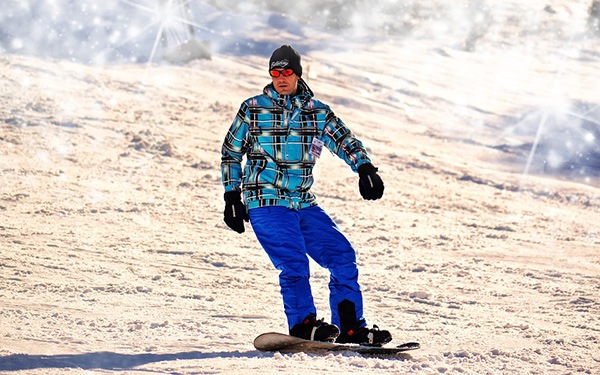
Asymmetrical
The asymmetrical shape is best suited to carving down hardpack.
Asymmetrical shaped boards have a larger sidecut on the heel edge meaning excellent edge hold, as well as a more confined turning circle — great for groomers.
Directional Asymmetrical
Directional asymmetrical boards are the number one boards for carving on groomers, usually requiring plenty of power and aggression behind them.
The nose is longer and more tapered than the tail, with stance being set back towards the tail.
Edge hold is unparalleled thanks to the sharp sidecut on the heel edge.
Twin Asymmetrical
This is where the nose and tail are the same shape with a center stance but with the same sharp sidecut on the heel edge.
Twin asymmetrical snowboards are most often favored by freestylers.
If you’re more of a visual learner, take a look at this video on the different shapes:
Construction
Another important specification to consider before buying your all mountain snowboard is its style of construction.
We’ll take you through the most common varieties.
Sidewall or Sandwich Construction
Sandwich is the most common type of construction found in the best all mountain snowboards.
As the name suggests, it’s where each layer of material is laid flat on top of each other. In order to protect the core, ABS sidewall is installed on the sides, which makes for excellent edge hold.
Cap Construction
Cap construction is out of fashion at the moment but it’s worth understanding all the same.
Essentially, it’s where the topsheet and fiberglass layers of the snowboard are encased over the core from above, automatically sealing the edges.
This construction makes for a very lightweight and poppy snowboard.
Half Cap or Hybrid Cap Construction
Hybrid cap construction is exactly that — a hybrid of cap and sandwich constructions.
It sees the fiberglass layer encasing the core from above, followed by the topsheet which is met by ABS sidewall to fully cover and protect the core.
This makes for good edge hold and a lightweight body.
Core
What material the core is made from is another highly important feature of the all mountain snowboard.
This is the powerhouse of the snowboard and the material that defines the strength and power of the overall board. Not only that, but it’s the material that every other material is attached to.
Here are the most common core materials:
Wood
Most cores are constructed from layers of laminated hardwood.
The density and strengths of the woods used will determine the power of the board.
Here are some oft-used woods:
- Poplar — mid hardness
- Ash, beech, maple — stiffer and heavier than poplar
- Bamboo — great for pop
- Birch — high power, low weight
- Balsa — lightweight so usually combined with harder woods
Aluminium Honeycomb
Super strong despite its lightweight, it’s an increasingly popular core material.
It’s not quite as dampening as a wood core is, however, so be prepared for some bumps along the way.
Carbon
It’s one of the most expensive core materials on the market, but many experts rate it highly for strong boards that are still lightweight and playful.
Kevlar
Another popular alternative to wood is kevlar.
Very strong with a good tensile strength, it’s a much better dampener than aluminium honeycomb — although it is a little heavier.
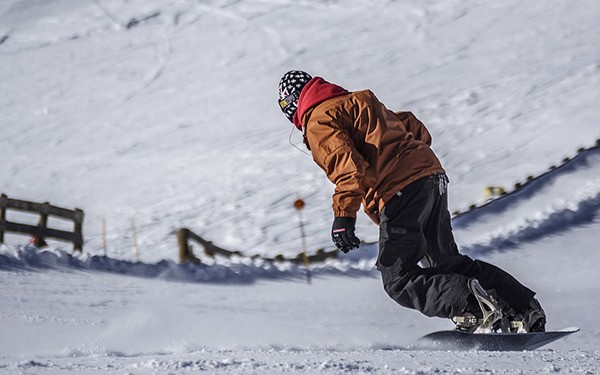
Flex
The final specification to think carefully about when it comes to buying an all mountain snowboard is how much flex the board has.
When we say flex, we mean how much the snowboard can bend between its nose and its tail — is it hard and stiff? Soft and flexible? Or somewhere in between?
As with so many of the specifications we’ve looked at for all mountain boards, you’ll generally be looking at medium flex snowboards to give you the best of all worlds.
Soft and flexible boards are generally best used by boarders in the park and those who like to perform plenty of tricks as they’re so maneuverable.
They also perform well at lower speeds — hence why beginners are often keen to start out with a softer snowboard.
Stiff snowboards on the other hand call for power. They’re generally best at high speeds and allow you to really take advantage of any edge hold. If you like to blaze down hardpack and have the confidence to really put some oomph behind your board, the stiffer the better.
Softer boards are generally more poppy, although many manufacturers have managed to inject some of that playfulness into stiffer boards too by adding a layer of carbon to the core.
Take a look at this vid for more info on flex:
The Best All Mountain Snowboards of 2020
OK — now you’re all clued, it’s time to countdown to the best all mountain snowboards of the year.
There’s a lot here: we wanted to give you as much choice as possible while catering to the widest set of preferences.
Let’s take it away…
Lib Tech Terrain Wrecker
- Profile: Hybrid rocker-camber
- Shape: Directional Twin
- Flex: Medium
- Construction: Sandwich
- Core: Wood
- Available lengths (waist widths): 145 (24), 148 (25), 151 (25.3), 154 (25.5), 157 (25.7), 160 (25.9), 161W (26.7)
First up, the Terrain Wrecker from Lib Tech may be our favorite graphics ever on a board. Seriously artistic.
But secondly, this is one of the best all mountain snowboards on the market — perfect for a variety of different abilities and experience levels, and a true workhorse in different terrains.
It’s a real all-rounder — just as good in fresh pow as it is carving down groomers, and it’ll even serve you well in the park. That’s not something we can say about every all mountain board on this list.
As an added bonus, it was made in the USA and the graphic artist is from the UK. We love some home grown talent.
Ride Warpig
- Profile: Hybrid flat with rocker
- Shape: Directional Twin
- Flex: Medium
- Available lengths (waist widths): 148 (26), 154 (27)
The Ride Warpig is definitely one of those all mountain snowboards that you either love or hate.
We love it.
It’s not exactly your run-of-the-mill all mountain. It’s short and fat.
But man, can this short little fatty ride! It’s pretty spectacular in practically every terrain we can think of and is a playful ride like no other.
It’s fabulously floaty in powder and can catch an edge like no other. You’ll feel like you’re flying as you zip down the mountain on this lightweight hog. Turn initiation feels almost completely different — better — to that with a more traditional board, and it’s a fantastic carver as well.
If you’re an advanced snowboarder who’s looking for something a little different this season — the War Pig could be your best bet.
Rossignol One LF
- Profile: Hybrid rocker-camber
- Shape: Directional Twin
- Flex: Medium-Stiff
- Construction: Sandwich
- Core: Wood, kevlar and basalt
- Available lengths (waist widths): 153, 156 (25.2), 157W, 159, 161W, 165W
The Rossignol One LF is a true joy of a snowboard — and one that we think is hugely underrated.
It’s got everything you might want in an all mountain board — playful with plenty of pop, highly responsive, a good dampener, super stable at high speeds, fantastic edge hold and a great floater in the pow.
What more could you want?
Well, to top it all off, it’s very well priced and offers tremendous value for money.
It’s not exactly perfect — it’s not the lightest board we’ve ever used, for instance — but it never feels sluggish or boring. A true all-rounder.
Gnu Space Case
- Profile: Hybrid rocker-camber
- Shape: Asymmetrical Twin
- Flex: Medium
- Available lengths (waist widths): 147 (24.7), 150 (25), 153 (25.1), 156 (25.5), 159 (25.5)
The Gnu Space Case is one of the best all mountain snowboards if you have a preference for park riding and jibbing.
It packs plenty of pop, butters well and is super playful.
But it’s a true all mountain too: it’s great at speed down the groomers, floats well in fresh powder and can also hold its own in uneven terrain.
We’d recommend it for recreational users all the way up to more experienced, advanced boarders who are looking for a park-friendly all mountain board that isn’t bothered about charging.
Jones Explorer
- Profile: Hybrid rocker with cambered nose and tail
- Shape: Directional
- Flex: Medium-Stiff
- Construction: Sandwich
- Core: Wood
- Available lengths (waist widths): 152 (24.9), 156 (25.2), 158 (26.2), 159 (25.4), 161 (26.4), 162 (25.6), 164 (26.6)
One of the things we can’t get enough of with the Jones Explorer board is the price — this is one of the best value all mountain snowboard that we’ve ever seen. Perhaps after the Rossignol One LF above.
It’s not necessarily the best board — but it certainly offers the most bang for its buck.
It’s lightweight, super poppy, great at floating in powder, while also being super stable and fast. It’s incredibly versatile and a great buy for someone looking for fun. We wouldn’t say it necessarily excelled in any single terrain, but it’s certainly capable at all of them. A true all mountain snowboard.
Lib Tech Travis Rice Pro Blunt
- Profile: Hybrid rocker-camber
- Shape: Twin
- Flex: Medium-Stiff
- Construction: Sandwich
- Core: Wood
- Available lengths (waist widths): 150 (24.7), 153 (25.3), 155 (25.5), 157 (25.8), 157W (26.3), 161.5MW (26), 161.5W (26.5), 164.5MW (26.2), 164.5W (26.7)
Some might class this as more of a big mountain board, but we’ll content that it’s great as an all mountain snowboard, with a certain preference for powder.
Let’s be real though: this board needs plenty of aggression to get the best out of it when you’re bombing and carving down groomers. Thankfully, the superior engineering makes for a lot of precision and control in pretty much every terrain — even in uneven crud.
It’s actually available with two different types of nose depending on your riding preference: blunt for jibbing or pointed for powder. We went for the blunt nose and were still really pleased with its performance in the fresh snow.
Burton Flight Attendant
- Profile: Camber
- Shape: Directional
- Flex: Medium-Stiff
- Construction: Sandwich
- Core: Wood
- Available lengths (waist widths): 152 (24.4), 156 (24.8), 159 (25), 159W (26), 162 (25.4), 162W (26.4), 168 (26)
We absolutely love the Burton Flight Attendant, although we would contend that it’s not a great board for jibbing in the park. In fact, we’d go so far as to say leave it at home if you’re jibbing!
What the Flight Attendant is good at, however, is keeping stable at high speeds. It’s an absolute monster bombing down hardpack and an excellent carver thanks to the superior edge hold.
It’s also fantastic in powder, good at initiating turns and can hold its own in the crud.
It’s certainly not the most playful all mountain snowboard we’ve ever tested, but it’s definitely reliable.
Burton Free Thinker
- Profile: Camber
- Shape: Twin
- Flex: Medium
- Construction: Sandwich
- Core: FSC Certified Super Fly II 700G Cre, Dualzone EGD
- Available lengths (waist widths): 150 (24.6), 154 (24.8), 157 (25.2), 157W (26), 160 (25.5), 160W (26.3)
Another Burton here — the Free Thinker.
Different from the Flight Attendant above, the Free Thinker is a great board for experienced, aggressive riders who love carving groomers and freestyling. It’s seriously impressive in this regard.
However, it really falls flat in the powder and takes a lot of effort to keep it afloat. Leave this board at home for backcountry riding.
It feels quite heavy, stiff and it comes with plenty of camber so we’d advise sticking to groomers and pushing it to high speeds.
Advanced snowboarders only need apply.
Arbor Wasteland
- Profile: Rocker
- Shape: Twin
- Flex: Medium
- Construction: Sandwich
- Core: Wood
- Available lengths (waist widths): 154 (25), 156 (25.1), 157W (26), 158 (25.2), 160 (25.3), 161W (26.2), 162 (25.4)
Snowboarders seem to be split over the appeal of the Arbor Wasteland — some think it’s too expensive for what is more of an intermediate board, while others highly value its ability to float in powder and overall maneuverability.
We’re somewhere in between.
It’s definitely nicely floaty and nimble, and would make a good all mountain snowboard for a rider not quite ready for a more advanced board. It’s priced a little highly — although we think it’s got the pop and stability to see you through for a while.
The sophisticated graphics are just classic Arbor. Real style on the slopes.
Roxy Sugar Banana
- Profile: Hybrid rocker-mild camber
- Shape: Twin
- Flex: Soft
- Construction: Sandwich
- Core: Wood
- Available lengths (waist widths): 138 (22.5), 142 (23.2), 146 (23.5), 149 (23.7), 152 (23.8)
The Sugar Banana from Roxy is one of our favorite women’s all mountain snowboards for 2020. And we’re not the only ones — this is one of the most popular women’s boards on the market right now.
Straight out the gate, this is a really poppy snowboard. If you’re taking it into the park or out on the fresh powder, you’ll really get the best from the Sugar Banana. It’s very soft so makes a great tool for jibbing and is really easy to initiate turns with.
We’d recommend it as a cracking all mountain snowboard for learning and improving your skills — whether that’s in the snow or in the park. You’ll definitely find your skills improving quickly on this board.
It’s not quite so brilliant on the groomers, but you’ll be able to hold your own with it — just don’t expect too much.
Gnu Ladies Choice
- Profile: Hybrid camber
- Shape: Assymetrical
- Flex: Medium-Soft
- Construction: Sandwich
- Core: Wood
- Available lengths (waist widths): 142.5, 145.5, 148.5, 151.5, 153.5
The Gnu Ladies Choice really lives up to its name — the ladies’ choice.
This is an absolute cracker of a women’s all mountain snowboard that delivers on versatility as well as any of the best men’s boards.
It’s a dream in fresh powder, has the superior edge hold to pull off carving at speed, while the unusual asymmetrical shape means fun times at the park.
We think it stands out best in turn initiation and jibbing. Soft and poppy, this is an absolute master of an all mountain snowboard.
Beaut graphics too.
What’s your pick for the best all mountain snowboard?

